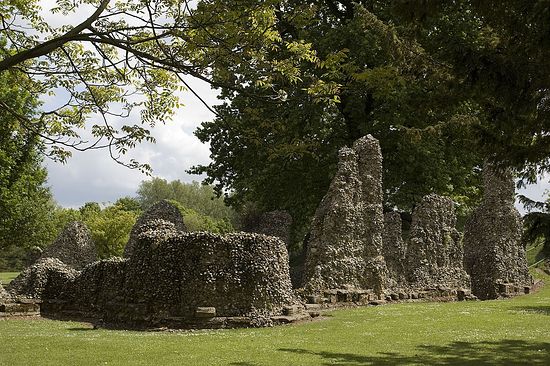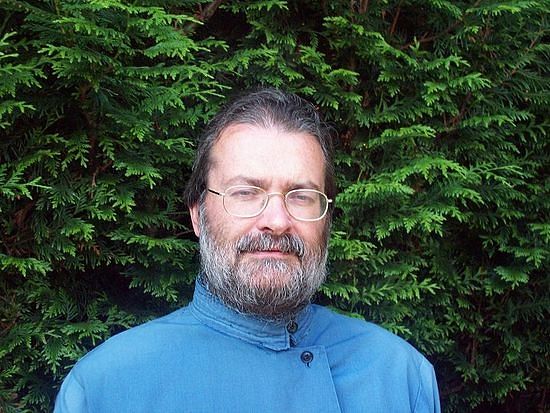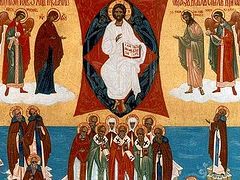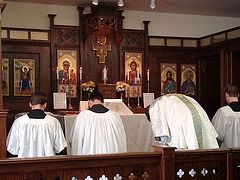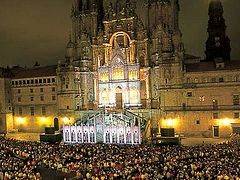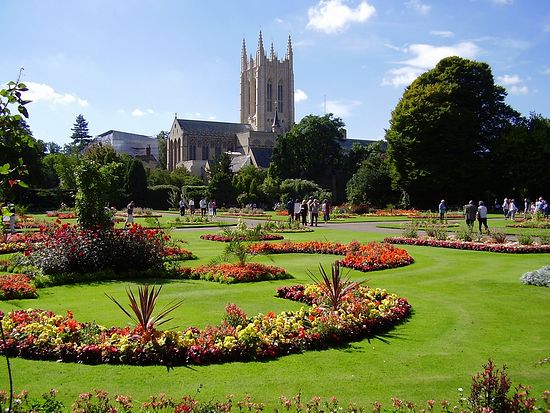 The Abbey Gardens in Bury St. Edmunds. Photo: http://wheredowe.co.uk/have-fun/abbey-gardens-bury-st-edmunds/
The Abbey Gardens in Bury St. Edmunds. Photo: http://wheredowe.co.uk/have-fun/abbey-gardens-bury-st-edmunds/ Three experiences and the great wonderment and many questions that they raised, all hinting at the existence of a much greater reality beyond the veil, have shaped and inspired my life. These experiences have all been of fragments and vestiges of the great Imperial Christian Civilization which was rejected over a period of between 1,000 and 100 years ago and has since been largely forgotten and lost. Although wholly rejected, derided and even unknown to most, this Civilization may yet, by Divine Providence and human repentance, be restored. That is our hope in our tiny corner of Eastern England.
My life has been spent in the task of fitting together these three experiences or pieces into a great whole, the big picture, where all these pieces belong. Only together as part of a whole do they have their full meaning. Alone they are just separate facts, tantalizing gleams and hints of some greater reality, keys to the great gates of a Kingdom that remains locked until you have all three of them and the daring to unlock them. With time, patience and prayer, by consulting many and reading the books of those whom I could not consult in life, with great effort, I have been able to put all the pieces together and found the big picture.
The Cottage of the People
The first experience came to me in childhood. In 1963, in a spot that I can take you to today, I sat with two nineteenth-century great-uncles, their caps respectfully removed, in the Abbey Gardens in Bury St. Edmunds. A host of silent questions arose in my mind. Why did they, such humble representatives of the people show such respect here? Who was this St. Edmund, that this town had been named after 1,000 years before? What was a saint? How did you become a saint? Why were there only ruins here now? And why were there no longer any saints? So many questions, so few answers and none able to answer them.
By the age of twelve St Edmund had led me to discover other local saints in my native Essex and Suffolk, Sts. Botolph, Cedd, Albright, Audrey, Osyth and Felix. Places and churches were named after them, but no-one could tell me very much about them. Their names had become an empty ritual of sounds, without any meaning, divorced from spiritual reality. I became aware that further away there were other mysterious saints, but they were all only fragments. Thus, as a child, I was thwarted, unable and unequipped to put any of these little pieces together, into the great, but mysterious and mystifying whole.
From August 1968 on I began to discover that these saints, however important they had once been locally, belonged to a far greater whole, to a universal background and culture, a whole Civilization, the Civilization of the Saints. I discovered that, once in their context, they would stop being names and stories in dry and dusty books and that they would come alive again and I could speak to them as my companions. This was all part of the greater discovery that what had been presented to me as Christianity was not that at all, but a system of tedious, State-organized ethics devised to control the masses.
Then came the realization that through its inevitable degeneration this false Christianity had been responsible for the opposite of authentic Christianity, Secularism. Whether in its Protestant or its Roman Catholic form, it lay outside the real Christian Church, the Orthodox Church. Finally, in 1972 when I visited the Soviet Union, I realized that the essential and largest part of the Orthodox Church was there, so cruelly persecuted and its integrity damaged, bringing people at worst to superstitious ritualism, Sovietized fragmentization. Outside that, there were other smaller Churches, but even more nationalized and compromised.
Having by my thirty-third year pieced together the saintly Cottage of the People and the holy Altar of the Faith that I served in the so troubled and sadly divided emigration, I began to understand that both Cottage and Altar had to be completed by the sacred Throne, the Throne of the Sacral Christian Empire, which depended on the Cottage and the Altar, but which also protected them both. In the Kingdom of Heaven there was no need for it, but on earth this was the glue that kept everything together. The Throne had been overthrown on earth many decades before. But what was the hope that the Throne could be restored?
At that time there seemed to be virtually none, for the Throne lay in ruins. The Imperial reality had been reduced to fragments, each tiny part claiming to be the Empire! It had been reduced to freemasonry and corruption, to fallen compromises and flag-waving provincialism, to sterile intellectualism and private personality cults. It had been betrayed by disincarnate modernists who could not see the greater picture, as they lived in the bubble of their own egos; they could not see the great forest as a result of looking for too long at their own little saplings. Could it, by the grace of God and human repentance, be restored?
Conclusion
Thus through the saintly Cottage of the People I discovered the Kingdom of the Spirit, through the holy Altar of Faith the Kingdom of the Son, and through the sacred Throne of the Sovereign the Kingdom of the Father. I had discovered in the saints the spiritual essence of the People, in the Faith Orthodoxy and in the Throne Sovereignty. I had discovered Christian Civilization, the opposite of the anti-Civilization that I had been born into, with its world wars, death camps, atomic bombs, cult of mammon and ruthless exploitation and genocide of Non-Europeans. I had seen the big picture, discovering the unique Christian Civilization.
Elitism despised and mocked the Cottage of the People; the Establishment falsified and compromised the Altar of the Faith; Secularism betrayed and scorned the Throne of the Sovereign. But I had seen the big picture, discovering the unique Christian Civilization. It could be called Roma Nova, the Third Rome or Holy Rus, though to some those terms have nationalistic undertones, but it is simply the Sacral Christian Empire. That Empire began in York on 25 July 306 and ended in Ekaterinburg on 17 July 1918. However, has it ended? Or has it merely been interrupted by “treachery, cowardice and deceit”?

